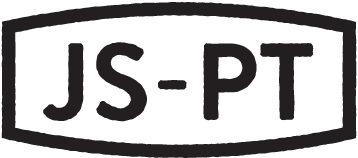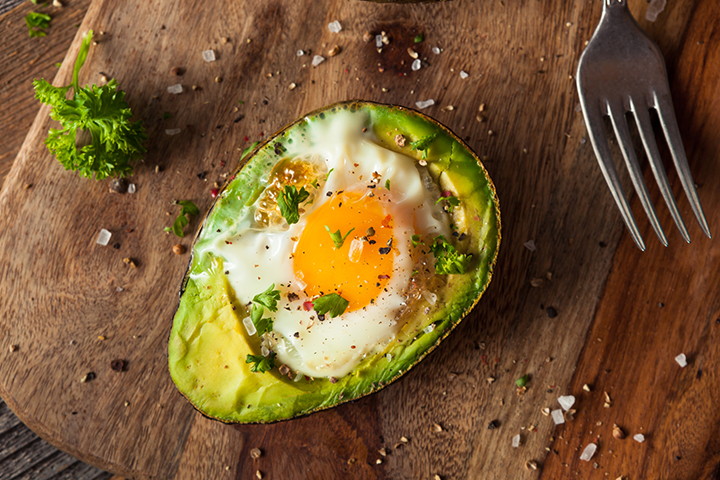
Start your day with an easy to prepare ‘protein and produce’ type breakfast, packed full of nutrients, and sugar free!
Ingredients:
- 6 avocados halved and seeded
- 6 large eggs
- salt and pepper, to taste
- 2 tablespoons chopped chives
Method:
- Preheat oven to 425 degrees F. Lightly oil a baking sheet or coat with nonstick spray.
- Using a spoon, scoop out about two tablespoons of avocado flesh, or more, as needed, creating a small well in the center of each avocado.
- Gently crack 1 egg, and slide it into the well, keeping the yolk intact. Repeat with remaining eggs; season with salt and pepper, to taste.
- Place into oven and bake until the egg whites have set but the yolks are still runny, about 15-18 minutes.
- Serve immediately, garnished with chives, if desired.
From https://damndelicious.net/2016/10/05/baked-eggs-in-avocado/
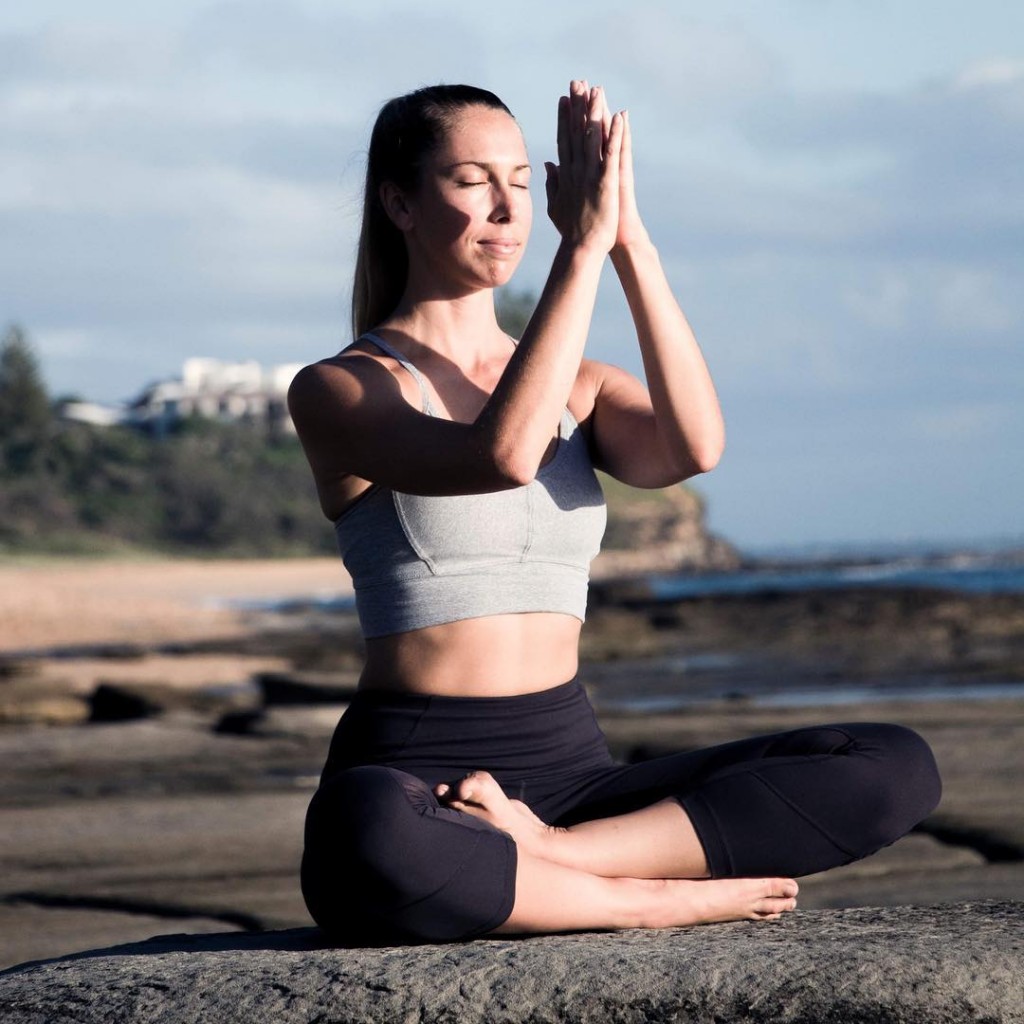
Are you working long hours and often hunched over a computer? Are you racing to and from back-to-back meetings whilst trying not to think about how you will manage the mass amount of emails coming in? Are you feeling stressed and rundown by the increasing demand on employees? As a fellow corporate professional I truly understand how close to home these are working in the corporate world. I have seen firsthand how gradually these detrimental work habits begin to take a toll on our bodies and minds in the form of stress, tension and sickness. Whilst a mild amount of stress can help us meet deadlines, too much or constant stress can have a significant impact on our overall wellbeing. We spend over one-third of our life at work, that’s why it’s so important that we introduce tools early to help us better handle workplace stress and improve our overall wellbeing in the corporate world.
One of these great tools I have found is Yoga. I’m sure you’ve heard of Yoga, but you may be wondering how turning yourself into a pretzel is going to help you in the workplace? Fair question, so let’s break this down.
Why Yoga?
Everyone has different triggers and reactions to stress and in today’s world, stress is inescapable. The good news is you can develop ways to handle stress through Yoga principles. Numerous studies have shown how Yoga can help to counterbalance the body’s physical, mental and emotional reactions to stress. Yoga is more than merely a physical practice and another element of yoga that is becoming increasingly common in the western world is meditation. Yoga not only assists in the daily pressures placed on the physical body, it can also positively affect your mental and emotional wellbeing through meditation and mindful practices.
You don’t have to be an advanced yogi to learn and apply these tools, so let’s have a look at three quick practices you can implement to better handle stress and improve your overall wellbeing in the workplace.
Desk Yoga
It’s not news that we’re all spending more time hunched over our desks creating tight hips and shoulders, a creaky neck and sore back. All the usual consequences of slouching at your desk for 8 hours a day. Sitting for prolonged periods of time can lead to imbalances in your body that cause poor posture and injury down the road. Yoga can help reduce discomfort and target areas of tension, being an effective way to counterbalance common physical ailments.
I’ve suggested 6 quick and effective stretches you can do at your desk in less than 5 minutes. If you need a visual, google these names for the image of the stretch:
• Seated neck stretch
• Wrist stretch and release
• Seated chair twist
• Desk shoulder opener
• Chair hip opener
• Standing forward fold
Taking some time in your workday to perform these quick stretches might just save you a more expensive trip to the physio!
Mindful breaks
In a world where busyness can be perceived as success, taking a lunch break can sometimes be frowned upon. However, what you do in your lunch break can have a huge impact on your productivity for the rest of the day.
Eating at your desk or spending your break aimlessly scrolling through social media can leave you feeling not very refreshed. Productivity reduces, it’s harder to focus and you may need that extra dose of caffeine to get you through.
So maybe step away from your desk and try a few of these:
• Take a walk around the block without looking at your phone. Really notice what’s going on around you and take in the fresh air.
• Eat your lunch mindfully. Take some time to appreciate the flavor and texture rather than rushing to eat while checking social media.
• Practice some mindful meditation in your break, deep breathing and paying attention to how you’re feeling.
Taking a deliberate break from work with a short walk or a bit of mindful relaxation can have powerful effects on our end-of-day concentration, stress, and fatigue.
Meditation
Research on meditation has shown it has many benefits, such as easing stress and anxiety and inducing feelings of tranquility and calmness. While the body needs constant movement to be healthy, the mind thrives with regular doses of stillness.
Our minds like to be busy to help us accomplish tasks, however this can also cause us stress and lack of focus. The good news is, we can train our minds to be calmer and more focused through the practice of meditation. Spending just 5 minutes in meditation can completely change the way you approach life and how your body responds to stress.
More popularly of late, the western world has been referring to ‘Mindfulness Meditation’. Here’s some quick tools as to how you can implement a 5-minute mindfulness meditation in your day. So set an alarm, and let’s get started.
• Find a comfortable position and close your eyes
• Feel which parts of your body connect to the floor
• Draw your attention to your natural breath, becoming aware of the sensation of each inhale and exhale
• Inevitably, your mind may wander, if it does, draw your attention back to the breath
• Notice the sounds around you
• Notice the temperature of the air on your skin
• If your mind gets carried away in thought, return your focus again to the breath
• When you’re 5 minutes concludes, gently open your eyes and notice what’s around you; colours, objects, people
• Pause for a moment and notice how you feel before continuing your day
There you have it, that’s it! Simple, quick and effective.
The practice involves training your mind to focus and be in the present moment without drifting into concerns about the past or future, which is where stress and anxiety can arise. Like any exercise, consistency is key. Give it a try next time you are standing in line, before a meeting, or anytime you need to regroup and have a moment of downtime. With regular practice, mindfulness meditation may also assist you in:
• Remaining calm under pressure
• Improving focus, attention and productivity
• Making decisions from a calm and grounded place
• Re-energise and clear your mind
• Experience less stress and anxiety
• A sense of connection
• Improved sleep
I hope you enjoy these tips on how you can easily implement yogic principles into your corporate day to better handle stress and improve your overall wellbeing. Like everything, start small and be kind to yourself, but most importantly, make a commitment to yourself as changes don’t happen overnight.
Sending calming vibes your way.
Diane Jeays
From Corporate Yogini (@coporate.yogini on Instagram)
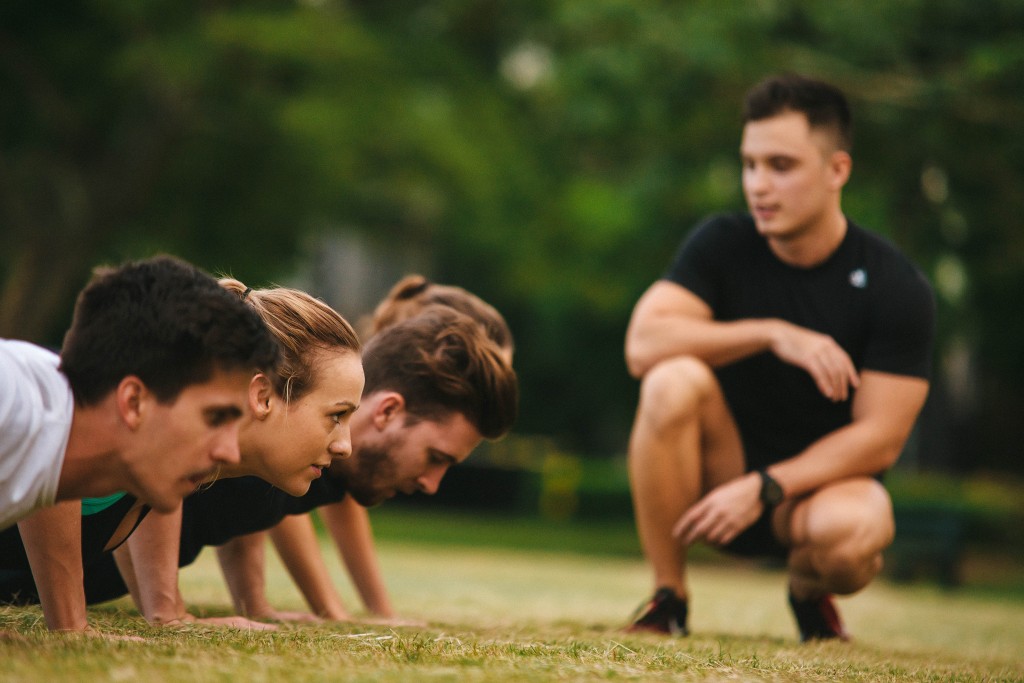
2018 is now in full swing – school holidays are officially over, the Australia Day long weekend has passed and everyone is now full steam ahead into the working year. Welcome back to a more consistent routine! With that in mind, now is the time to establish some healthy habits to get you moving towards your health and fitness goals fast. Whilst the following this isn’t rocket science, being on top of these few steps will ensure you are moving forward efficiently. Here are 5 habits to master to transform your body.
1. Moving more outside of your gym sessions
Whilst everyone’s new year goal tends to be to go to the gym more, or to eat better, when it comes to getting back in shape, something that’s often overlooked, but that is so simple to do, is to just move more in general. Aiming for 30-60 minutes of activity each day in addition to your gym or boot camp sessions ensures you are more active more often. This goal is especially beneficial for people who sit down at a desk all day. Options to move more could include going for a walk when you wake up or during your lunch break, parking further away, or simply just taking the stairs. Walking also aids in your recovery and digestion. Taking up a social sport or activity to mix things up with your normal gym routine is beneficial too given you can catch up with friends while being active.
2. Sleeping 7-9 hours per night
Sleeping more is one of the most overlooked aspects of fat loss, muscle gain and improved performance. Your body recovers primarily when sleeping, so getting some shut eye for 7-9 hours each night will give the body time to rebuild the torn muscle tissues which occur during training and ensure you are recovered adequately for whichever physical activities you may do the following day. Lack of sleep causes a drop in certain hormones (leptin) which play a key role in how ‘full’ you feel, making you more likely to consume more calories through snacking and cravings. Remember, quality counts, so limit the phone and Netflix before bedtime!
3. Controlling your portion sizes
Whilst we’ve recommended the approximate counting of calories through apps such as ‘My Fitness Pal’ in the past (which we still maintain is a useful tool to educate people on the macronutrient and calorie breakdown of different foods), calorie counting can be flawed due to the inaccuracy of food labels and the potential negative and obsessive effect it can have on your eating behaviours. So, with that in mind, try measuring portion sizes using the palm of your hand as a simple and flexible guide – this idea stems from our friends at Precision Nutrition. Aim for 80-90% of your diet coming from whole foods, with the remaining 10-20% spent on whatever you like, assuming you are eating adequate amounts of protein.
4. Increasing water intake and limiting liquid calories
Maybe you’ve read that increased water intake assists with fat loss, but it is not water per se that achieves this, but rather the effect that it may have on your drinking habits, in particular, by replacing ‘liquid calories’ you may have – such as juices, soft drinks or alcohol – with water intake. Drinking enough water per day (2-3L per day) has major health benefits. Studies have shown adequate water intake assists in the transfer of nutrients throughout the body, flushes out toxins, lubricates your joints and digestive tract, and regulates your body temperature through sweating. One particular study which was conducted a few years back showed that drinking 500ml of water increases your energy expenditure (calories burnt) by 24% (1). With this in mind, drink plenty of water before exercise and before meals as this is likely to increase your metabolism for the following hour and make you feel more full before eating.
5. Being mindful of recovery and managing stress
Being mindful of recovery is often something that is overlooked when people increase their activity levels. Above we mentioned the importance of sleep for recovery, but don’t forget that stretches and foam rolling maintains and improves your flexibility and mobility (recovery) too. Yoga is an obvious option here given you focus on not only stretching, but also the calmness of your mind through controlled breathing. Yoga also helps you mix up your exercise routine – lower intensity activities such as yoga, walking, pilates and meditation, combined with higher intensity exercises such as resistance training, conditioning and cardio provides a good mix of endorphin releasing and mindfulness exercises. Another very simple technique to help deal with stress is spending time in nature. Whether that is just by eating lunch in a park, or adding more greenery to your household or office, nature helps lower your stress hormones and heart rate, and improves your mood.
References
1. Boschmann M, Steiniger J, Franke G, Birkenfeld AL, Luft FC, Jordan J. Water drinking induces thermogenesis through osmosensitive mechanisms. J Clin Endocrinol Metab. 2007 Aug;92(8):3334-7.

You can have the best nutrition plan in the world, but if your compliance to the plan is low, your results will be minimal. Those that travel for work often know all about the challenge of remaining compliant with their plan, and even those that travel occasionally can relate. If you fall into this category, then the following strategies will help you increase your adherence to a nutrition plan.
Choosing the best location
Whether you’re away for a conference for a couple of nights or working in an interstate office for the week, your first priority should be location. Not just in relation to where your work commitments are, but how close are you to supermarkets/gyms/restaurants from your hotel? Are you within walking distance? Without these type of places being close, it’s easy to make poor selections.
Choosing a room with kitchenette
Price is an obvious factor here, but a room with a kitchenette or even just a fridge, you can stock the room with healthy snacks/meals such as fresh fruit and vegetables, yoghurts, breads, sliced chicken/turkey, milk, bottled water etc.
Research restaurant menus in advance
If you intend on eating out, hop onto the websites of the possible restaurants where you intend on eating so you know what could potentially fit into your plan.
Bring protein supplements
Often the biggest challenge for people who travel often (even those who don’t) is maintaining adequate amounts of protein. If you are using the above strategies then you should be doing well to maintain sensible eating patterns, but bringing your own protein powder down is a good and quick fall back option if you aren’t able to eat as well as you would like.
While these are pretty simple steps to take when travelling, sometimes it is easier said than done to be compliant with a good eating plan. Put into place these strategies and help increase the likelihood of you remaining on track with your nutrition goals.
Inspired by Precision Nutrition
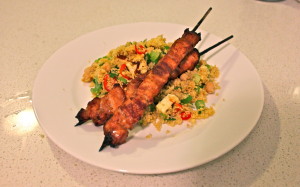
Kebabs, couscous, haloumi, and chilli. Four things I love! An easy recipe with a good amount of protein and flavour which doesn’t keep you in the kitchen for very long. Check it out below.
—
For the Couscous salad:
Method:
1. Bring stock to boil in a saucepan over high heat. Place couscous in a large bowl and pour the boiling stock over. Stir through with a fork. Leave covered for 5 minutes and stir through with a fork again to separate the grains.
2. Cut up haloumi into smaller pieces. Heat saucepan with oil over medium heat, and add haloumi. Cook for approximately 1-2 minutes each side or until golden brown.
3. Add haloumi to couscous along with spring onions, chilli, and chickpeas.
4. Make the dressing: whisk lemon rind, 1/4 cup lemon juice, paprika and oil in a bowl until properly combined.
5. Pour dressing over salad. Serve!
For the chicken kebabs:
Method:
1. Preheat a BBQ or pan on medium high, cook the kebabs while turning until properly cooked through.
2. Serve!

Diets, diets, diets…
It’s all the craze lately isn’t it? 30 Day cleanses, celebrity endorsements, sugar free this, paleo that. It’s hard not to be a little curious and question whether one diet is right for you. The question of which one is best for weight loss is certainly something that has been brought up in conversation with me in the last month or so. My answer has remained the same though: whichever diet or plan you can sustain for the long term is the diet that is right for you.
Those who follow the Facebook page must think I sound like a broken record, but the fact of the matter is, all health related goals should be made with a long term view. It should fit your lifestyle, and it definitely should take into account your personal preferences if you want to succeed, because what Pete Evans (Chef from My Kitchen Rules) may eat may not be what you want on your plate every day. Each person’s individual needs are different.
Be consistent with your plan, be flexible enough to enjoy a variety of foods, and be patient! I can’t stress that last point enough. Ups and downs are inevitable, so don’t beat yourself up and instead remain focus on the overall goal.

This breakfast/dessert idea is so simple a recipe is hardly needed. Here’s how it was done anyway.
Serves 1
1 ripe banana, peeled
1/2 cup Greek yogurt
2 tablespoons fruit jam or preserves
2 tablespoons sliced almonds or other nuts OR granola as is in the photo
1/4 cup fresh berries or other fresh fruit
Split the banana lengthwise and lay the two halves in a shallow bowl. Scoop out the yogurt and put it on top of the banana. Warm the jam in the microwave for 15 to 30 seconds or until it is very runny.
Use a spoon to drizzle the jam over the yogurt, and sprinkle the granola/nuts over everything. Top with raspberries/blueberries and dig in!
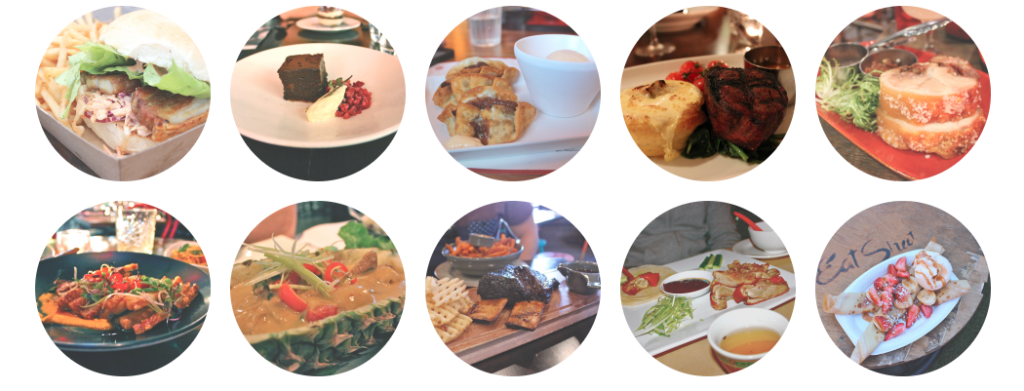
Strict ‘all or nothing’ approaches to food plans for clients are common amongst personal trainers and nutritionists. Often they result in failure due to their lack of flexibility. I’m all for being fit, healthy, and looking the part, but if a diet doesn’t have variety or allow me to indulge in foods I love, I’m not interested. Nonetheless, there is a diet option where you can literally, ‘have your cake and eat it too,’ and that’s by applying the moderation guideline. The moderation guideline is the 10-20% rule which is outlined in greater detail by leading nutritionist Alan Aragon.
In essence, the 10-20% rule allows you to eat whatever you want but still look great naked! Well, not quite, but with all things in life, everything should be in moderation. The basis of your diet should still come from whole and minimally refined foods. Reaching your minimum daily protein and fat intake (which varies for each individual) is still vital. If you are ticking these boxes, then consuming your go to indulgence foods is perfectly fine, as long as they are in moderation (10-20% of your daily Calorie target). Often dieting is too much of a psychological battle to stay within the parameters of a food plan because of lack of flexibility and variety, but with the 10-20% rule, this allows for indulgences more often than just the common ‘cheat meal.’ Of course, if someone chooses to have 0% of their food coming from sweets or processed food, that’s also perfectly fine.
As Alan Aragon has said, “Honouring personal preference is one of the most powerful yet underrated tactics for achieving optimal health and body composition.” Remember though, greater dietary flexibility is achieved by how high or low your physical activity levels are. So basically, consistent exercise is very important.

Superior Fruit Graceville
I’m sure many of you are familiar with, have seen or have heard of the glycemic index (GI). You know, those commercials and food labels that tell you why a particular food is more healthy because it is ‘low GI’. In short, the GI is a measure of how quickly a given food can raise blood sugar. The test is done solely on a specific carbohydrate food with a score between 1-100.
High GI foods such as sugar, white potatoes, cereal etc raise blood sugar more quickly, thus are scored higher. Low GI foods such as whole grains, nuts and vegetables do not cause the same rises in blood sugar, so are scored lower… But, do all the meals we consume only consist of high GI foods, or low GI foods? No. They are often a mix of both.
Consuming a high GI food (for example white potatoes) as part of a mixed meal of lower GI foods (vegetables, legumes) with a lean protein, would more than likely mean the overall GI of the meal is quite low. The vegetables and legumes in this case may slow the digestion of the white potatoes.
What does this mean for you?
Well, while you may see a lot of marketing to do with high GI and low GI foods, or have heard of people cutting out potatoes because of their GI score, just remember the GI index should not govern someone’s carbohydrate choices exclusively. Many different types of food both low and high GI have a wide range of vitamins and minerals which can benefit your health.
Eat a variety of whole and minimally processed foods and enjoy what is on your plate!
The best diets are the ones that consume all sorts of nutrients, as well as improve the performance, body composition (the amount of lean mass and fat mass present; basically how you look) and health of that individual.
To have a diet which contains all types of nutrients, you need to have VARIETY! Eating the same things each day, even if they are considered ‘good’ foods, means you are likely deficient in other areas of your nutrition.
Eat for your own health, your own performance, and your own body composition, but do yourself the favour and achieve all of that by eating a wide range of foods.
“Variety is the spice of life”

Healthy eating doesn’t have to mean you avoid the foods you love, nor does it have to mean hours and hours of food prep. Check out this recipe below for a simple and easy to prepare Thai dish (who doesn’t like Thai food?) which contains a great mix of macronutrients, and most importantly is delicious!
Method:
Step 1: Heat half the oil in a wok over high heat until just smoking. Add the almonds and stir-fry for 1 minute or until golden. Transfer to a heatproof bowl.
Step 2: Add half the chicken to the wok and stir-fry for 2 minutes or until brown. Transfer the chicken to the bowl with the almonds. Repeat with the remaining chicken, reheating wok between batches.
Step 3: Heat the remaining oil in the wok. Add the onion, broccolini, chilli and garlic and stir-fry for 2 minutes or until the broccolini is bright green and tender crisp. Add almonds, chicken, shallot and chilli jam and stir-fry for 2 minutes or until heated through.
Step 4: Spoon the stir-fry among serving bowls. Sprinkle with basil and serve with steamed rice.
